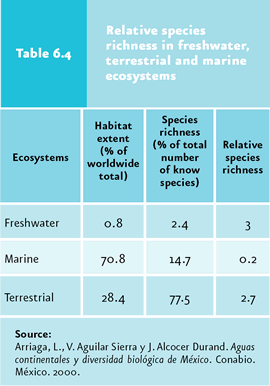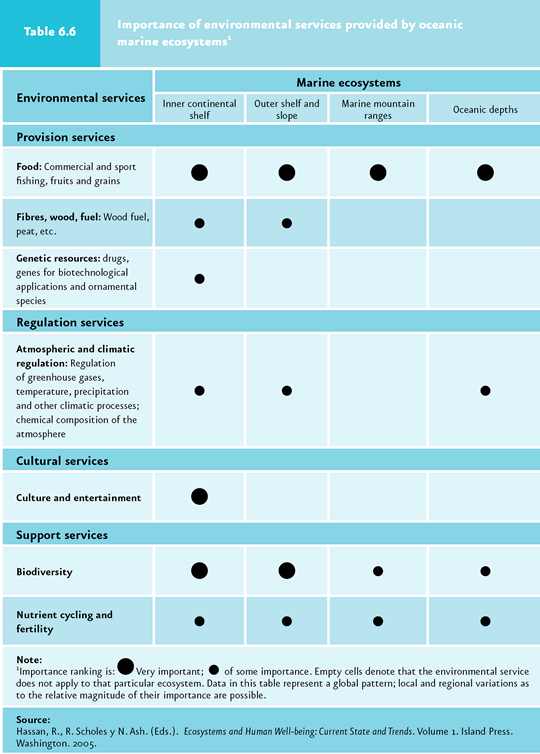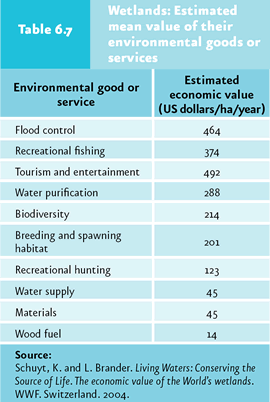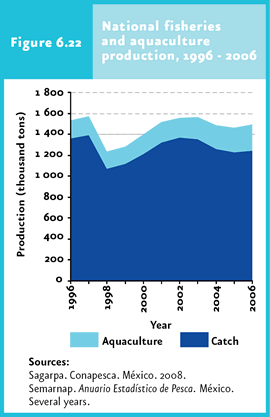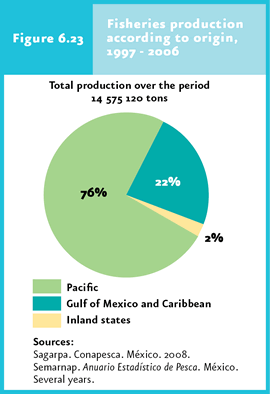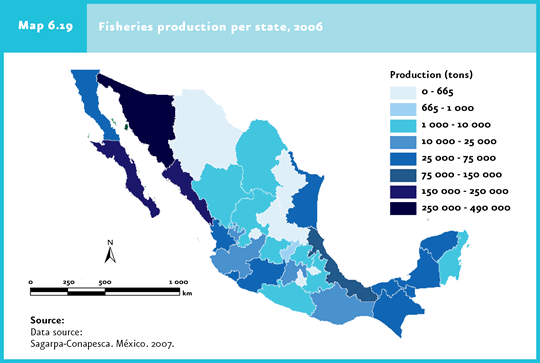
Aquatic ecosystems play a key role in the hydrological cycle. |
Forty percent of the 25 thousand known fish species worldwide are freshwater species, although lakes and rivers represent a mere 0.3% of the planet’s water. |
The main threats for inland aquatic biodiversity include habitat reduction or degradation, the introduction of invasive species, overexploitation of fish resources and climate change. |
Eighty one rivers and 3 thousand 295 kilometers of watercourses are totally or partially included within Mexico’s federal ANPs. |
| CHAPTER 6. WATER |
Although traditionally the topics related to water availability and quality and aquatic ecosystems (both continental and marine) are treated separately, they are closely related. Aquatic ecosystems, including freshwater, coastal and marine systems, are deeply involved in the hydrological cycle, acting as the most important water reservoirs, on the one hand, and as the primary sources of water vapor reaching the atmosphere and subsequently returning to these as precipitation and runoff, on the other. To this respect, they act both directly and indirectly on the local and regional water balances, that is, on water availability. In parallel, they function as receptors and filters of the pollutants that are carried by water flowing into them, thereby purifying and improving the quality of water. Inland water bodies are formed by the interaction between topography and water input from rainwater or from snow and glacier melting. Inland water bodies host a wide range of ecosystems ranging from ponds and intermittent rivers to springs, permanent rivers, lakes, lagoons and estuaries. Their ecological features vary according to the specific conditions in their basins, climate, soil, vegetation type and biodiversity. Inland aquatic ecosystems can be divided into lotic systems, that is, those with waters permanently in movement and corresponding mostly to surface currents (e. g. rivers and streams) and lentic systems, which are natural or man-made water reservoirs (e. g., lakes, impoundments and dams; Arriaga et al., 2000). Rivers draining into the Pacific Ocean are generally short and fast flowing and have steep slopes, whereas those flowing into the Gulf of Mexico and the Caribbean Sea are generally long and large and have gentle slopes. The most important rivers in terms of their mean annual volume are, on the Pacific slope, the Colorado, Yaqui, Fuerte, Culiacan, Lerma-Santiago, Balsas, Papagayo, Ometepec, Verde, Tehuantepec and Suchiate rivers; on the Gulf slope, these are the Bravo, Panuco, Tuxpan, Papaloapan, Coatzacoalcos, Grijalva and Usumacinta rivers; on the Caribbean slope, the Hondo river. The most important inner rivers are Nazas-Aguanaval, Santa Maria, Casas Grandes and El Carmen. The lentic water bodies include about 70 lakes of various sizes that, together, cover a surface area of nearly 371 thousand hectares. Most lakes in the country are located along the Trans-Mexican Volcanic Belt, mainly associated with the Lerma-Santiago system. The Central-Western area (which includes the states of Jalisco and Michoacan) is the most important one on this respect, as it includes the largest lakes: Chapala, Cuitzeo and Patzcuaro. Man-made dams are also noticeable, as the more than 4 thousand water-storage facilities currently existing cover a surface area larger than that covered by natural water impoundments. The largest man-made dams in Mexico are La Amistad, Falcon, Vicente Guerrero, Alvaro Obregon, Infiernillo, Cerro del Oro, Temascal, Caracol, Requena and Venustiano Carranza. There is a large diversity of marine and coastal ecosystems in Mexico. The Mexican littoral stretches over some 11 thousand kilometers, bathed by the waters of three large marine basins: the Pacific Ocean, the Gulf of Mexico and the Caribbean Sea. The length of the littoral and its environmental diversity allow the existence of a multitude of natural ecosystems including mangroves, coastal lagoons, marshlands, estuaries, tidal plains, barrier islands, sea grass communities and coral reefs. Likewise, the huge extension of the exclusive economic zone (about 315 million hectares, that is, 1.6 times the continental area) comprises a wide range of environments, including submarine canyons, abyssal plains, submarine mountains and volcanoes, hydrothermal vents and trenches, all of which undoubtedly significantly enrich the country’s biodiversity.
Freshwater and marine biodiversity In absolute terms, inland aquatic ecosystems harbour relatively few species, but their number per unit area is slightly higher than the one found in terrestrial ecosystems and nearly 15-fold the one observed in marine ecosystems (Arriaga et al., 2000; Table 6.4). Worldwide, the richness of aquatic species is extremely high: 40% of the 25 thousand known fish species are freshwater species, even though lakes and rivers only represent 0.3% of the planet’s water (PNUMA, 2004).
Estimates point out that the country´s inland aquatic fauna comprises 384 fish species, 280 amphibians, 41 reptile and 361 bird species characteristic of aquatic environments (Aguilar, 2003). The rivers with the highest fish diversity are Panuco (75 species, 30% endemics), Lerma-Santiago (57 species, 58% endemics), Coatzacoalcos (53 species, 13% endemics) and Papaloapan (47 species, 21% endemics; Miller, 1986; Figure 6.21). The plant species richness is estimated at 763 species of aquatic plants, including ferns, gymnosperms and angiosperms (Aguilar, 2003).
Some of the most important lacustrine systems in terms of biodiversity and high number of known endemisms are the Chapala lake, the crater lakes of the Eastern Basin, the Catemaco lake, the Chichankanab lagoon and the Media Luna Lake. Cuatro Cienagas, in the State of Coahuila, is a particularly important site, as this small area is home to 12 crustacean species (half of them endemics), 33 mollusks, 16 fish (most of them endemic and endangered of extinction: Dionda episcopa, Cyprinodon atrorus, Lucania interioris and Cichlasoma minckleyi, among others), a herpetofauna comprising 70 species and 61 aquatic birds (Arriaga et al., 2000). Mexico’s marine biodiversity, as throughout the world, is less known than that of freshwater and terrestrial environments. The technical difficulties and the economical cost of marine research have significantly restrained the biological knowledge in this area. Many studies currently available cover only particular regions or locations, which makes it difficult to derive country-wide figures. Aguilar and coworkers (2008) estimate that, worldwide, the ratio of studies on terrestrial biodiversity to studies on marine biodiversity is about 10 to one. Nevertheless, reliable information is available for some groups in terms of species richness. For hermatypic, or reef-forming corals, between 63 and 81 species have been estimated for Mexico, accounting for 8-10% of the species known worldwide (Carricart-Ganivet and Horta-Puga, 1993; Spalding et al., 2001). As to marine mammals, 45 species have been recorded, mostly in the Gulf of California (Conabio, 2006), one thousand 600 marine algae species, between one thousand and one thousand 300 polychaete species, nearly 2 thousand crustaceans and over 500 echinoderms (Arriaga et al., 1998).
Environmental goods and services provided by aquatic ecosystems Natural ecosystems provide multiple goods and services that are essential for the day to day life and development of society. These goods and services are the result, ultimately, of biodiversity and the ecological processes taking place naturally and that maintain the ecosystems functioning (see also chapters Terrestrial Ecosystems and Biodiversity). Currently, the importance of environmental goods and services has been better recognized in view of the economic and technical difficulty of replacing them once the ecosystems have been degraded or destroyed in a given region. Although freshwater for human consumption is one of the most important goods provided by inland aquatic ecosystems to mankind, there are others that are of no less importance (Table 6.5; for further information see Daily et al., 1997, Wilson and Carpenter, 1999, MEA, 2005). For example, as to goods that are directly valued in the market, besides potable water, are means for transportation of humans and merchandises (e. g. rivers and lakes), electricity generation, food supply (e. g. fish, mollusks and crustaceans, among others) and crop irrigation. As to goods and services with no market value, the role played by wetlands in the regulation of floods resulting from heavy precipitation events (thereby avoiding or reducing human and economic losses derived from flooding), maintenance of a rich biodiversity (including not only species used as food or sources of materials, but also those sustaining the ecosystems), nutrient recycling (through biogeochemical cycles), water purification by eliminating household and industrial waste and climate regulation at both local and regional levels.
Coastal and marine ecosystems also provide multiple environmental goods and services. In addition to fish products that supply an important proportion of the protein intake of the world population or raw materials used in constructions (e. g. limestone and sand), coastal ecosystems (mangrove forests and coral reefs) protect coastal populations from strong winds and waves produced by tropical storms and hurricanes, serve as nursing sites for many species of economic importance and maintain a high biodiversity (Table 6.6).
Even though estimates of the economic value of environmental services are scarce due to the difficulty to calculate them, in the case of aquatic ecosystems it may be as high as several thousand dollars per hectare, which translate to “free” benefits for the population which, were not available, would represent a huge economic investment (Table 6.7). In Mexico, for instance, it has been found that fish and crab production in the Gulf of California is directly related to the local abundance of mangrove forests: the economic value of that production has been estimated at about 37 thousand 500 dollars per hectare of mangrove forest (Aburto-Oropeza, et al., 2008). It should be kept in mind that the loss of biodiversity and integrity of these ecosystems may lead to a significant decrease in the amount and quality of the environmental goods and services they provide.
Environmental services provided by aquatic ecosystems: the case of fisheries For their economic value and production volume, fishing products are the most important goods obtained from aquatic ecosystems both in inland and oceanic areas worldwide. Fisheries contribute around 20% of the annual protein intake of at least 2 thousand 6 hundred million persons throughout the world (UNEP, 2007). Preliminary estimates of the world´s fish catch for 2005, based on the reports issued by some of the major fishing countries, point out that the production (including both inland and marine catch and aquaculture) reached one hundred 42 million tons, a figure higher in one million tons than that recorded in 2004 and which represents a record global production. For its part, it is worth noting that aquaculture is fastest growing sector of animal food production, with an annual rate near 8.8% since 1970. By contrast, fishing yields have grown at a mere 1.2%, whereas inland meat production systems grow at 2.8% (FAO, 2007). Aquaculture represents 22% of the global fish production and 40% of the fish consumed as food in the world (MEA, 2005). Mexico’s fish production has remained relatively unchanged over the last years, with 1.464 million tons per year for the period 1986-2006 (Figure 6.22; Cuadro D2_PESCA01_02). The 2006 production was around 1.5 million tons in live weight, 83% of which came from fish catch and 17% from cultures or aquaculture (Cuadros D2_PESCA01_02 and D2_PESCA02_01;IB 2.2-6).
If fish production is analyzed at the regional level, the states at the Pacific slope contributed 76% of the total production between 1997 and 2006, with about 14.6 million tons per year on average, The states at the Gulf and Caribbean slopes yielded 22% (around 318 million tons per year), and those with no littorals contributed only 2% (33 thousand tons per year) of the total national fish production (Sagarpa, 2007; Figure 6.23; Cuadro D2_PESCA01_01).
Over 50% (nearly 866 thousand tons) of the total national fish production in 2006, including both fisheries and aquaculture, came from only four fisheries (tuna fish, sardine, other fish and shrimp) and sardine represented 35% of these, with a production estimated at over 500 thousand tons. The states that contributed the highest volumes to the country´s fish production in that same year were Baja California Sur, Sonora and Sinaloa, with over 897 thousand tons per year altogether (Map 6.19; Cuadro D2_PESCA01_01).
Impacts on inland aquatic biodiversity The strong dependence of human societies on environmental goods and services supplied by inland water bodies has jeopardized the existence of many species and, consequently, the integrity and proper functioning of the ecosystems they inhabit. In general, it can be stated that the extent of the threat that inland aquatic ecosystems currently face is greater than that of forest or coastal ecosystems (Revenga et al., 2000). Pollution, over exploitation and the introduction of invasive species impose additional threats to biodiversity: approximately 20% of fresh water fish species are threatened, endangered or extinct in recent decades due to this pressures (Revenga et al., 2000). Over 50% of inland aquatic ecosystems (except for lakes and rivers) have been lost in some regions of North America, Europe and Australia (see the Box Global issues of marine ecosystems). Pressures on fresh water ecosystems and their biodiversity come from two sources: directly, through the impact from the loss or degradation of areas occupied by these ecosystems, or by the extraction and introduction of species; and indirectly, by the effects that may result from alterations in water flow and quality needed to maintain the optimum functioning of these ecosystems. Both types of effects can occur in the areas occupied by these aquatic ecosystems or in their basins. Therefore, nutrient laden agricultural surface runoff flowing from the upper basins may reach and pollute, through small affluents, large rivers or lakes downstream. The main threats for inland aquatic biodiversity include habitat reduction or degradation, introduction of invasive species, overexploitation of fish resources and climate change (UNESCO-WWAP, 2007). However, the modification of watercourses by the construction of dams and impoundments and water overexploitation and pollution by agricultural, municipal and industrial discharges are also important sources of degradation of these ecosystems (Table 6.8).
Pressure imposed by these factors on aquatic ecosystems has inevitably led to the loss of species. Worldwide, there are more freshwater species endangered of extinction than in terrestrial or marine environments. According to the International Union for the Conservation of Nature´s (IUCN) Red List, there are 3 thousand 676 freshwater species listed as vulnerable, threatened or extinct worldwide (IUCN, 2007). From these, one thousand 92 are fish and one thousand 73 are amphibians (UNESCO-WWAP, 2007). The Mexican Official Standard NOM-059-SEMARNAT-2001 that lists the wild animal and plant species and subspecies endangered or threatened of extinction, rare and those subject to special protection, records 394 inland aquatic vertebrates included in any of these categories, 169 of which are fish, 197 amphibians and 28 reptiles. The same Standard records 16 fresh water fish species already extinct in the country (DOF, 2002; IB 6.2-4). In coastal and marine environments, the human population and development have also imposed a heavy impact on the ecosystems, mostly due to the high proportion of the world population that inhabit coastal areas, exploiting their natural resources and disposing of their waste in them. In the year 2000, about 40% of the world population lived within 100 kilometers from the coastline (CIESIN, 2006). In Mexico, littoral development has also been important: the population living in coastal municipalities grew, between the year 2000 and 2005, at 1.5% per year, from 18.9 to 20.4 million inhabitants (IB 6.3-5). Population growth has a direct impact on coastal and marine ecosystems, mostly as a result of infrastructure construction (piers, dykes and wave-breakers, among others), overexploitation of natural resources, inadequate disposal of solid waste, and the discharge of untreated municipal waste water. Fishing is one of the human activities that most heavily impact coastal and oceanic biodiversity. The impacts of this activity come both, from the reduction in the population of target species and the unintended capture of other organisms (the so-called “incidental catch”), as well as through the lack of selectivity of traditional fishing methods. Fishing also affects directly the marine communities by altering the habitats and modifying the food chain dynamics. According to the 2004 National Fishing Chart, 33 of the 42 major coastal lagoon systems in Mexico are affected by fishing activities, 27 of them are located on the Pacific coast and the rest on the Gulf and Caribbean coasts. From the perspective of marine fisheries, this same chart establishes that in the Gulf of Mexico and the Pacific Ocean, 19 and 27% of the fisheries, respectively, are currently deteriorated, 67 and 51% have already achieved the maximum sustainable yield, and around 15% still have potential for further development (DOF, 2004). One of the most serious issues that fisheries are facing today is the lack of selectivity of traditional fishing gear, which leads to the catch of specimens from many fish and invertebrate species with no commercial value. In the case of the shrimp fisheries in Mexico, for instance, the incidental catch includes around 125 fish species, 2 mollusks, 2 echinoderms and 4 crustacean species; 4 of those species are listed in the NOM-059-SEMARNAT-2001 under some risk category. Other fisheries can also catch threatened vertebrate species, including cetaceans, sharks and sea turtles (Cuadro D2_PESCA04_02). It is hard to estimate the damage that incidental catch has caused in Mexican waters. Only in the year 2000, the incidental catch discarded from shrimp vessels reached nearly 176 thousand tons in the Pacific Ocean, whereas in the Gulf of Mexico and Caribbean Sea this figure was around 15 thousand tons (Cuadro D2_PESCA04_01). Some fishing gear also disturbs the marine environment by destroying the habitat of many species. Trawls sweep the marine bottom searching for shrimp and other bottom-dwelling fish species, causing marine grasses, sponges, corals and sea-urchins, among other organisms, to be damaged, captured or dislodged from the sea bottom. The loss of the microhabitats that are created by sponges and corals also conveys the loss of grounds for the recruitment, nursing and feeding of other species, thereby affecting their populations and the flow and dynamics of trophic chains. Even though no periodical data are available on the surface area that is swept every year in the search for shrimp and other bottom-dwelling species in Mexico, in the year 2000 it was estimated that, only in the Pacific Ocean, nearly 550 thousand square kilometers were swept (that is, nearly twice the size of the state of Chihuahua), whereas in the Gulf of Mexico and the Caribbean Sea it may have reached 187 thousand square kilometers (that is, an area equivalent to the size of the state of Sonora; Cuadro D2_PESCA04_01). The introduction of nonnative species has also changed the original composition of inland aquatic ecosystems. These species have been introduced either intentionally for aquaculture, sports fishing or biological control, or accidentally as a result of the escape of ornamental species. These species affect native flora and fauna as a result of habitat degradation, predation, competition and introduction of diseases. The number of invasive species that have established in inland aquatic ecosystems in Mexico is currently 76: two amphibian species, 55 fish, 10 plants, 4 crustaceans, one semi aquatic mammal, 2 turtles, one mollusk and one jellyfish; the distribution ranges of these species virtually encompass all the national territory (Conabio, 2008; IB 6.2.-2). In the case of marine invasive species, 42 species have been reported as established: one amphibian, 3 fish, 9 crustaceans, 6 mollusks, 18 algae and 5 species from other invertebrate groups (Conabio, 2008; IB 6.3.-8).
Instruments for the conservation of aquatic biodiversity In Mexico, as in other countries, a number of schemes aimed to the protection of inland and marine aquatic biodiversity have been put in place. Some of these schemes focus directly on the protection of ecosystem integrity (like Natural Protected Areas or the wetlands of the Ramsar convention), whereas others act through the regulation of the use of particular species or groups of species (for example, fishing standards and bans), which may affect the structure of these ecosystems, and therefore, their biodiversity. The establishment of natural protected areas (ANP from their initials in Spanish) has been the most widely used conservation strategy in Mexico and around the world (see also the chapter on Biodiversity). The main role of ANPs is the protection and conservation of natural resources of special importance, including both animal and plant species or representative ecosystems at the local, regional or international level. With regard to inland aquatic ecosystems, a total of 81 rivers and 3 thousand 295 kilometers of their watercourses are included either totally or partially within Mexico’s federal ANPs. The Santa Maria, Grande de Santiago, Bravo, Sabinas and San Fernando rivers are those having most of their length included within ANPs. In the year 2008, there were a total of 4.5 million hectares of marine areas within the Mexico´s system of Natural Protected Areas (IB 6.3-10). It is worth noticing that an important number of ANPs including inland and marine aquatic ecosystems have been regarded as Priority Hydrological Regions (RHP from their initials in Spanish, of which there are 110 in Mexico) and Priority Marine Regions (RPM from their initials in Spanish, 70 in all) as defined by Conabio, which are characterized by their high biological diversity and ecological integrity (Map 6.20 and 6.21).
Parallel to the ANP scheme, there are additional conservation strategies including the Ramsar Convention (this is further detailed in the Box Wetlands and Ramsar sites, and the indicators IB 6.2-5 and IC 2) and the Payment for Hydrological Environmental Services Program (PSAH from its initials in Spanish), launched in 2003, through which government resources are provided to the owners of well preserved temperate and tropical forests, as a payment for the public benefits that their conservation provides (for further details, see the chapter Terrestrial Ecosystems; IB 2.2-14; IC 2). Even though this program is specifically focused on forest land given its importance for the hydrological cycle, it also offers an alternative to forest clearing for agriculture and cattle raising, which are the major causes of the loss of natural vegetation cover in Mexico. Along with the ecosystem conservation schemes, there are additional instruments used for the protection of aquatic resources, especially in the case of fishing. Some species can be indirectly protected through these instruments and, hence, also the biodiversity of ecological communities. A number of strategies have also been implemented to reduce the volume and impact of incidental catch. One of the most important efforts to reduce the incidental catch of sea turtles has been implementation of the so-called Sea Turtle- excluding Devices (DET in Spanish), launched in 1993 in the Gulf of Mexico shrimp-fishing fleet, and in 1996 in the Caribbean and Pacific fleets (IB 6.4.2-5; see also the Box Mexican sea turtles, in the chapter Biodiversity). The tuna fishery also requires close supervision by technical monitors to warrant compliance with national and international standards and hence reduce incidental dolphin catches. Efforts implemented for dolphin protection started in the mid 1970’s, and two programs are currently in place (one national and another international) for the progressive reduction of incidental mortality. Both programs are based on monitoring incidental mortality b scientific observers since 1991. The Emergency Mexican Official Standard NOM-EM-002-PESC-1999 updates the previous regulations in dolphin protection matters within the framework of the Agreement on the International Dolphin Conservation Program (AIDCP) and the Inter-American Tropical Tuna Commission (CIAT for its initials in Spanish), and incorporates the “incidental dolphin mortality limit” (LMD) per vessel as the basic control instrument. Among the major issues associated to fishing activities in Mexico are conflicts derived from access to resources, the vague definition of ownership rights, overexploitation, the inefficiency of catching techniques leading to incidental fishing, the concentration of fishing efforts in a few species, and pollution and destruction of the habitat of target species (Villaseñor-Talavera, 2002). Within this context, the fishing regulations currently in place in Mexico, such as the Law of Fisheries and its regulations, the standards, notices and bans, have been developed following the criteria for responsible fishing, in an attempt to make good use of fish resources. Two of the legal instruments that have been promoted to achieve a sustainable development of fisheries in Mexico are licenses and Mexican Official Standard. The license is the most widely used instrument, given that, according to the Fishing Law, this is a requirement for any commercial exploitation. License issuing depends on the resource availability and on the fact that exploitation would not deteriorate the fishing management unit. In 2004, 30 fisheries had instruments of this sort (Semarnat, 2005). Another usual way of protecting fish resources is to allow the exploitation of organisms that have already reproduced (in general, through setting minimum sizes for capture), as well as bans and the prohibition of pernicious fishing gear. The development and implementation of a legal framework to regulate the use of fish resources in Mexico is a core element in the administration of fisheries. However, the legal framework by itself is not sufficient to guarantee its rational use, nor its protection and preservation. For this reason, an integrated management system should consider, in addition to the above, the interests of the various social sectors and the interactions among them, along with the proper monitoring and surveillance system supporting the legal framework, and considerations of the biological and ecosystemic aspects that guarantee the sustainability of fisheries (for further information see the Box Ecological marine land-use planning in the chapter Terrestrial ecosystems). |
